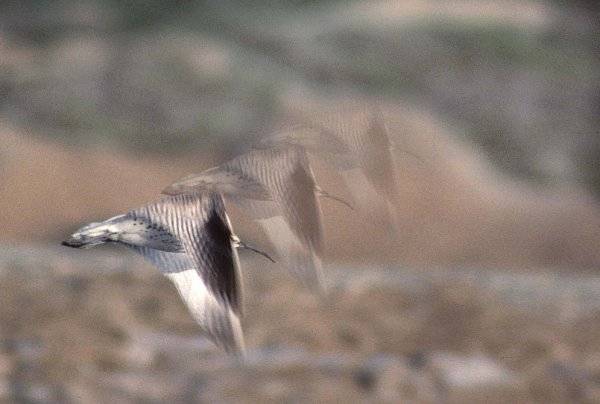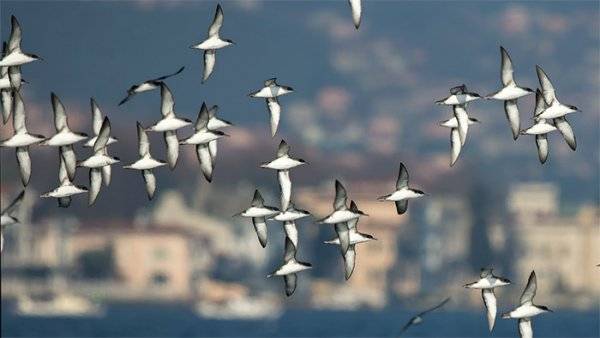Guest blog by Graeme Buchanan

Of all the birds that have occurred in the OSME region, the slender-billed curlew is now perhaps the most enigmatic. Even after the recent review by Guy Kirwan et al. of records from the region, it is clear from the historical distribution of the species that the Middle East was both a passage and wintering area of this critically endangered species. But the last record of the species with irrefutable evidence comes from Morocco in 1995. While there have been possible sightings, none of them have been supported by concrete evidence. Finding this species is high on the wish list of many birders based in the OSME region, or members of OSME who frequently travel to this region.
This passion and drive from birders enabled an impressive volunteer survey effort at the beginning of the decade to try to find the lost slender-billed curlew. A new paper in Bird Conservation International documents this effort, and highlights the benefits that accrued from it. Over 50 expeditions searched over 20 countries, many within the OSME region, for passage or wintering birds. This search was coordinated by the RSPB and BirdLife International, through the Slender-billed Curlew Working Group (SBCWG). This working group, established in 1997 in the framework of the 1994 Memorandum of Understanding concerning Conservation Measures for the Slender-billed Curlew, was re-invigorated around 2009.
Historical records of the species were used to target surveys to areas that were known to be occupied in the past, or which were thought to be suitable for the species. Survey teams generally consisted of a mix of individuals from overseas and birders from within the country being surveyed. The surveys didn’t record any slender-billed curlews, although there were a couple of possible sightings around the Black Sea. However, there were multiple ancillary benefits that are documented in the paper:
- “observers recorded over half a million birds (615,465) from 414 species. Some 19 species of conservation concern (threatened or near threatened species based on the IUCN 2011 Red List) were recorded in the wintering area.”
- “serious threats were noted to at least 10 IBAs, including loss to development of around 1 ha per week of mudflats at Lake Qarun, Fayoum, Egypt, and in Morocco, the Oued Moulouya and Sebkha Bou Areg from which there are previous records of Slender-billed Curlew are under increasing pressure from development“
- “observer records, many of which come from areas with sparse ornithological survey coverage, make a useful contribution to conservation. Observers were encouraged to enter records into online recording databases (e.g. worldbirds.org)”
- “most of the international observers were from western and central European countries, but by working with individuals within the countries being surveyed, the capacity of many individuals and organisations was developed, and some involved began to routinely survey wader flocks”
Our surveys indicated just how strong the passion of birders can be. Surveyors are prepared to spend their own time and money searching for a species. And even if these efforts do not result in the focal species being recorded, it is not a wasted effort. With correctly designed methods and well briefed teams, it is possible to collate a vast amount of useful information.
And the lack of records should not be taken as bad news. Small curlews are difficult to identify and slender-billed curlew could easily be overlooked. The potential for birds to remain undetected is illustrated by the steppe whimbrel Numenius phaeopus alboaxillaris. This sub species, which is likely to occur in the OSME region, has recently rediscovered in Mozambique (soon to be published in Bulletin of The African Bird Club). The vastness of the areas means they could easily have been overlooked too. The search should continue. In our paper, we suggest searches should also be targeted at a number of areas which were not surveyed fully or areas which the survey teams identified as potentially suitable, including Isle Kneiss in Tunisia, Merja Zerga, Oued Tahadart, Sidi Moussa-Oualidia and Khnifiss in Morocco, the southern end of Sabkhat al Jabbul in Syria, Eastern banks of Great Bitter Lake, Zaraniq Protected Area and Hamata – Red Sea Coast in Egypt. Anyone seeing a potential slender-billed curlew should take detailed notes and photographs. These will be essential to assess the veracity of the record. They should contact the slender-billed curlew working group without delay (nicola.crockford@rspb.org.uk). Further information on slender-billed curlews, including a downloadable identification leaflet can be found at www.slenderbilledcurlew.net. And keep an eye open for steppe whimbrel and send records- to Gary.Allport@birdlife.org.
Finally, the authors of the paper express their gratitude to all those who took part in these surveys and who provided data. The list is long, but thank you all.
The full paper citation is: Crockford, N.J. & Buchanan, G.M. 2017 Volunteer survey effort for high-profile species can benefit conservation of non-focal species. Bird Conservation International. doi:10.1017/S0959270916000186
Also see the following paper; Kirwan GM, Porter, RF & Scott, DA. 2015. Chronicle of an extinction? A review of Slender-billed Curlew records in the Middle East. British Birds 106: 669-681.
Graeme Buchanan is first and foremost a birder, and birding has taken him to every continent (except Antarctica). He works for RSPB as Principal Conservation Scientist in the International Research section of the RSPB Centre for Conservation Science. Much of his work involves the use of spatial data, including remote sensing data, to inform conservation priorities. When not birding, he can be found cycling one of his fleet of bikes near where he lives just outside Edinburgh, UK.



